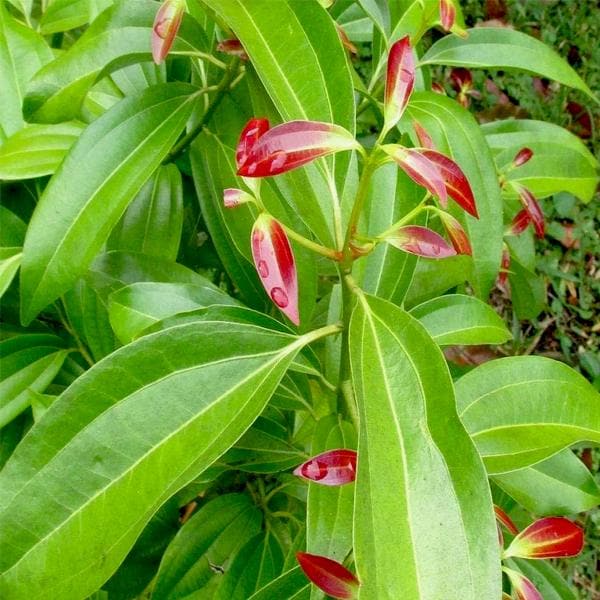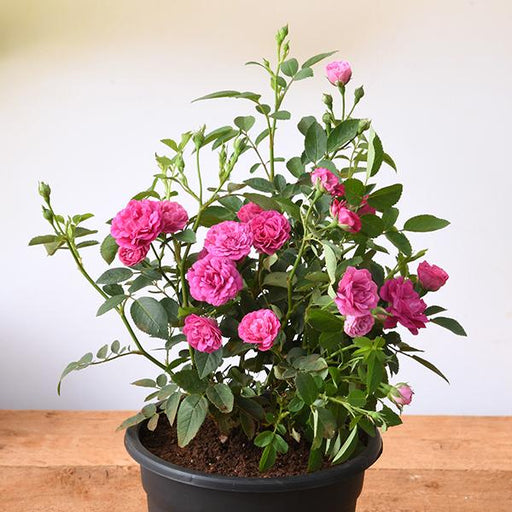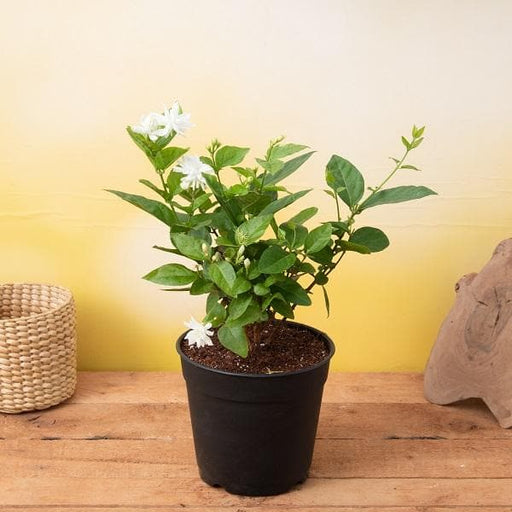
True Cinnamon, Bay Leaf, Tamala Patram - Plant
(MRP Inclusive of all taxes)
- Shipping ₹79 for entire order
- Dispatch in 7 days
- Country of origin: India

(MRP Inclusive of all taxes)
 Save 29%
Save 29%
Air Purifier Money Plant with Pot The Air Purifier Money Plant, also known as Pothos or Epipremnum aureum, is a stunning indoor plant that...
View full details
 Save up to 15%
Save up to 15%
Peace Lily, Spathiphyllum - Plant The Peace Lily, scientifically known as Spathiphyllum, is a stunning houseplant celebrated for its elegant white...
View full details
 Save 25%
Save 25%
Jasminum sambac, Mogra, Arabian Jasmine - Plant Jasminum sambac, commonly known as Mogra or Arabian Jasmine, is a fragrant flowering plant...
View full details
 Save 18%
Save 18%
Combo Constituents Includes the Parijat Tree (Night-Flowering Jasmine), a culturally significant plant with fragrant flowers. Description The Pari...
View full details
 Save 25%
Save 25%
Miniature Rose, Button Rose (Any Color) - Plant The Miniature Rose, also known as the Button Rose, is a charming and compact flowering plant that ...
View full details Save 25%
Save 25%
Damascus Rose, Scented Rose (Any Color) - Plant The Damascus Rose, also known as Rosa damascena, is a timeless symbol of beauty and romanc...
View full details
 Save 17%
Save 17%
Beautiful Fragrant Mogra, Arabian Jasmine Plant with Pot The Beautiful Fragrant Mogra, also known as Arabian Jasmine (Jasminum sambac), is...
View full details Save 15%
Save 15%
Pack of Vermicompost and Neem Cake for House Plants Transform your indoor garden with our premium Pack of Vermicompost and Neem Cake, spec...
View full details
Pack of Plant Growth and Flower Boosters Unlock the full potential of your garden with our Pack of Plant Growth and Flower Boosters! This ...
View full details Save 38%
Save 38%
Combo of Jeevamrut and Neem Raksha for Easy Growth and Protection of Houseplants Transform your indoor garden with our exclusive combo of ...
View full details Save 22%
Save 22%
Plant Nutrients Kit (Pack of 16) for a Healthy Garden Transform your garden into a lush paradise with our Plant Nutrients Kit, featuring 1...
View full details Save 16%
Save 16%
Combo of Top Plant Fertilizers Elevate your gardening game with our exclusive Combo of Top Plant Fertilizers, featuring two bags of premiu...
View full details Save 24%
Save 24%
Pack of 4 Additives to Make Soil Healthy and Nutrient Rich Transform your garden into a thriving ecosystem with our Pack of 4 Additives de...
View full details Save 30%
Save 30%
Transform your gardening experience with our premium Combo of Perlite and Vermiculite. This unique blend is designed to enhance soil aeration and ...
View full details Save 27%
Save 27%
Combo of 2 Vermicompost and Cocopeat - Enrich Your Soil Naturally! Transform your garden into a thriving ecosystem with our Combo of 2 Ver...
View full details
 Save 35%
Save 35%
Best 6 Plants for Perfect Indoor Garden Transform your living space into a lush oasis with our curated collection of the Best 6 Plants for a...
View full details
 Save up to 50%
Save up to 50%
Mini Succulent Garden Pack Transform your space with our Mini Succulent Garden Pack, featuring a delightful collection of 4 any variety beautiful s...
View full details
 Save 30%
Save 30%
5 Best Fragrant Plants Transform your garden or indoor space into a fragrant paradise with our curated selection of the 5 Best Fragrant Plants. Th...
View full details
 Save 24%
Save 24%
Set of 2 Bonsai Looking Grafted Adeniums Transform your indoor or outdoor space with our exquisite Set of 2 Bonsai Looking Grafted Adenium...
View full details Save 45%
Save 45%
Top 4 Die Hard Succulents Pack Transform your indoor or outdoor space with our Top 4 Die Hard Succulents Pack, featuring a curated selecti...
View full details
 Save 30%
Save 30%
5 Best Indoor Plants Pack Transform your living space into a lush oasis with our '5 Best Indoor Plants Pack.' This carefully curated collection fe...
View full details
 Save 25%
Save 25%
Set of 4 Evergreen Air Purifier Plant Pack Transform your indoor space into a lush, green oasis with our Set of 4 Evergreen Air Purifier Pla...
View full details| SrNo | Item Name |
|---|---|
| 1 | True Cinnamon, Bay Leaf, Tamala Patram - Plant |
Discover the aromatic world of True Cinnamon (Cinnamomum verum), Bay Leaf (Laurus nobilis), and Tamala Patram, a trio of culinary and medicinal plants that elevate your garden and kitchen. Known for their rich flavors and health benefits, these plants are not just herbs; they are a gateway to a healthier lifestyle. True Cinnamon is revered for its anti-inflammatory properties, while Bay Leaf adds depth to dishes and Tamala Patram is celebrated in traditional Indian cuisine.
This unique plant combination offers a blend of flavors and health benefits that are hard to find elsewhere. True Cinnamon is often referred to as "Ceylon cinnamon," known for its superior quality and lower coumarin content compared to Cassia cinnamon. Bay Leaf is a staple in Mediterranean cooking, while Tamala Patram is a key ingredient in Indian dishes, making this plant a versatile addition to any culinary repertoire.
These plants are not only flavorful but also environmentally friendly. They contribute to biodiversity and can be grown in home gardens, promoting sustainable practices. Additionally, they have historical significance, with cinnamon being used in ancient trade routes and bay leaves symbolizing victory in ancient Rome.
True Cinnamon, also known as Ceylon cinnamon, is the spice that dreams are made of. Unlike its impostor cousin, Cassia, True Cinnamon boasts a delicate flavor profile that dances on your palate. It’s the spice that says, “I’m fancy!” while still being versatile enough to spice up your morning oatmeal or your evening chai. Plus, it’s packed with antioxidants, making it the health-conscious choice for those who want to indulge without the guilt.
Bay leaves are the unsung heroes of the culinary world. They may look like simple green leaves, but toss one into your pot, and it transforms your dish from “meh” to “magnificent.” These aromatic leaves are like the secret agents of flavor, working behind the scenes to enhance soups, stews, and sauces. Just remember to fish them out before serving; they’re not meant to be eaten, but they sure know how to spice things up!
Tamala Patram, or Indian bay leaf, is the exotic cousin of the common bay leaf. With a more robust flavor and a hint of sweetness, it’s the spice that adds a touch of mystery to your dishes. Often used in biryanis and curries, it’s like the VIP guest at your dinner party—everyone wants to know who brought it! Plus, it’s a great way to impress your friends with your knowledge of Indian spices.
Planting a tree is like giving Mother Nature a high-five. It’s a simple act that can have a monumental impact on the environment. Trees provide oxygen, improve air quality, and offer shade on those scorching summer days. Plus, they’re the ultimate multitaskers, providing homes for wildlife while also being a source of delicious fruits and nuts. So, grab a shovel and get planting; your future self (and the planet) will thank you!
True Cinnamon isn’t just a pretty face; it’s also a health powerhouse! Packed with anti-inflammatory properties and antioxidants, it’s like a tiny superhero for your body. Studies suggest it may help regulate blood sugar levels and improve heart health. So, sprinkle some on your morning coffee and feel like you’re doing something good for yourself—because you are!
The battle of the cinnamons is real! True Cinnamon (Ceylon) and Cassia may look similar, but they’re as different as night and day. Ceylon is the delicate, sweet one, while Cassia is the bold, spicy contender. If you’re looking for quality, go for True Cinnamon; it’s the spice that won’t let you down. Plus, it’s less likely to contain coumarin, a compound that can be harmful in large doses.
Bay leaves are the culinary equivalent of a secret ingredient. They’re not just for soups and stews; they can elevate rice dishes, marinades, and even desserts! Toss one into your slow cooker, and watch as it works its magic, infusing your meal with a subtle depth of flavor. Just remember, it’s a flavor enhancer, not a main course—so don’t go overboard!
Sustainable tree planting is like giving a gift that keeps on giving. It’s not just about planting any tree; it’s about choosing the right species for your environment and ensuring they thrive. This eco-friendly practice helps combat climate change, supports biodiversity, and creates beautiful green spaces. So, roll up your sleeves and get involved; your local ecosystem will thank you for it!
True Cinnamon is the fairy dust of the baking world. Whether you’re whipping up cinnamon rolls or spicing up your apple pie, this aromatic spice adds warmth and comfort to your baked goods. It’s the secret ingredient that makes your kitchen smell like a cozy café. So, don’t skimp on the cinnamon; let it shine in your next baking adventure!
In Indian cuisine, bay leaves are like the spice cabinet’s best-kept secret. They add a subtle flavor that enhances the richness of curries and biryanis. Often used in tempering, they’re the aromatic touch that elevates your dish from ordinary to extraordinary. So, next time you’re cooking Indian food, don’t forget to add a bay leaf; it’s the spice that says, “I know what I’m doing!”
The benefits of tree planting are as vast as the trees themselves! From improving air quality to providing shade and habitat for wildlife, trees are nature’s multitaskers. They also help combat climate change by absorbing carbon dioxide. So, when you plant a tree, you’re not just beautifying your space; you’re making a positive impact on the planet. It’s a win-win situation!
True Cinnamon, also known as Ceylon cinnamon, is the fancy cousin of the common cassia cinnamon. It’s sweeter, more aromatic, and less bitter, making it the superstar in the spice world. If you want to impress your taste buds, this is the cinnamon you need to sprinkle on your morning oatmeal!
Bay leaves are like the secret agents of the culinary world. They add depth to soups and stews while also boasting health benefits like aiding digestion and reducing inflammation. Just remember to remove them before serving; they’re not meant to be eaten, unless you enjoy a surprise crunch!
Tamala Patram, or Indian bay leaf, is the aromatic leaf that adds a unique flavor to Indian dishes. It’s not just a pretty leaf; it’s a flavor powerhouse that elevates biryanis and curries. Think of it as the VIP guest at your dinner party—essential for a memorable meal!
Using True Cinnamon is as easy as pie—literally! Sprinkle it on desserts, stir it into your coffee, or add it to savory dishes for a warm, sweet twist. Just remember, a little goes a long way, so don’t go overboard unless you want a cinnamon explosion!
While you could use dried thyme or oregano in a pinch, nothing quite matches the unique flavor of bay leaves. They’re like the cool kids in the spice rack—hard to replace! If you must substitute, just know you’re missing out on that signature aroma.
Not quite! While both are bay leaves, Tamala Patram has a distinct flavor profile that sets it apart. It’s like comparing a classic rock band to a jazz ensemble—both are great, but they play different tunes. Use Tamala Patram for a unique twist in your dishes!
You can find True Cinnamon at specialty spice shops, health food stores, or online retailers. Just make sure you’re getting the real deal—Ceylon cinnamon—because nobody wants to be stuck with the impostor! Check labels and trust your spice sense!
Store bay leaves in an airtight container in a cool, dark place, like your spice cabinet. They love to stay fresh and aromatic, so don’t leave them out in the open like a celebrity on a red carpet. Proper storage ensures they’ll be ready to work their magic when you need them!
Absolutely! Growing Tamala Patram at home is like having your own spice garden. Just provide it with well-drained soil, plenty of sunlight, and a little love. Soon, you’ll have fresh leaves at your fingertips, ready to elevate your culinary creations!
True Cinnamon is a versatile spice that can be used in both sweet and savory dishes. From cinnamon rolls to curries, it adds warmth and depth. It’s like the Swiss Army knife of spices—ready to tackle any recipe you throw its way!
While bay leaves are generally safe, consuming them whole can be a choking hazard. They’re like the party guests who don’t know when to leave—great for flavor but not for eating! Stick to using them for flavoring and remove them before serving.
Quality Tamala Patram should be vibrant green, aromatic, and free from blemishes. If it looks like it’s been through a spice war, it’s best to pass. Fresh leaves will have a strong, pleasant aroma, so trust your nose—it’s your best tool in the spice game!